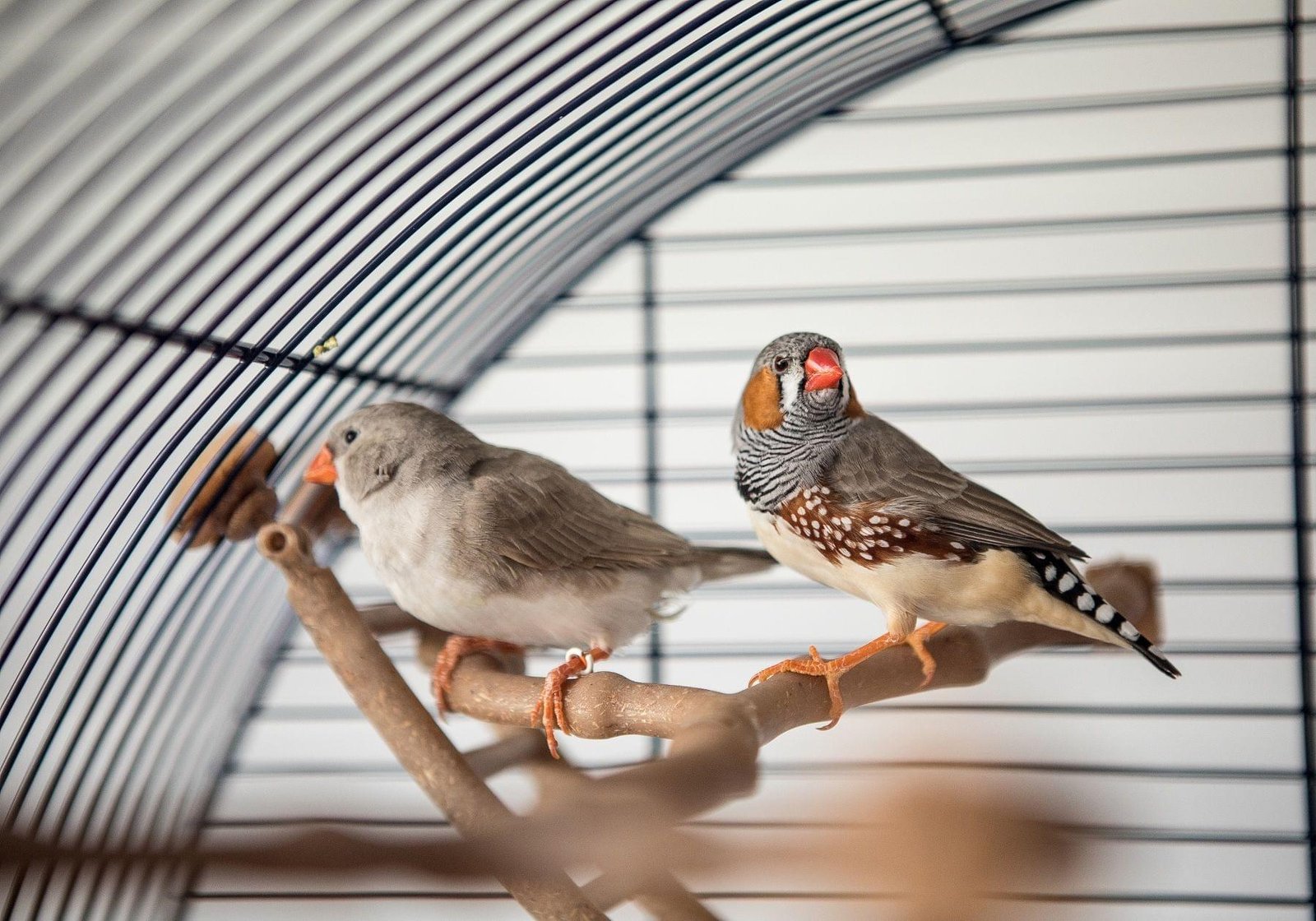Many bird and vertebrate species form pair bonds and mate with only one other individual for the majority of their lives. However, unions do not always work. Scientists are interested in the underlying causes. and they got to know about animal divorce.
A zebra finch couple must first find a place to live before they can start a family. Whether it’s in a tree or a nest box, the male is usually in charge of finding a good nest site—though the female’s opinion can make or break a decision. “The male will kind of go from one nest site to the next, and they’ll check it out together,” explains evolutionary biologist Kerianne Wilson, who spent hundreds of hours observing zebra finch behavior in aviaries as part of her PhD research at the University of California, Irvine in the 2010s. “If the female doesn’t like it, she’ll leave,” in which case the male will usually “have to coax her into house-hunting again.”
Wilson explains that disagreements about potential nesting sites can arise for a variety of reasons. Aggressive neighbors are especially bothersome for communal songbirds like zebra finches (Taeniopygia guttata), which live in colonies of several dozen members. Individual birds differ in their assessments of the pros and cons of a particular nest site, and it is here that socially monogamous zebra finch couples, which live together and share parenting responsibilities while raising multiple cohorts of young, can run into trouble. Wilson claims that some couples simply appear to be incompatible when it comes to house hunting, resulting in lengthy searches. These birds risk passing up a good, or even a passable, nesting site. If the male and female “really can’t get on the same page,” Wilson says, they may end up trying to raise their young in two different nests. In most cases, however, incompatibility in nest preference predicts a more decisive outcome: divorce.
Sponsered5
Wilson and colleagues studied the behavior of zebra finch pairs—identifiable by bonding behaviors such as snuggling up to each other, grooming, and joint house-hunting—that were exposed to unfamiliar individuals during the breeding season in recent experiments with flocks kept in aviaries in California. The team discovered that bonded pairs were more likely to split up with their current partner and join forces with a new one if they had visited a greater number of nest sites.
The study, which was published online late last year, is one of only a few that have experimentally investigated why pairs of monogamous animals split up. Indeed, despite being described in a number of species throughout the twentieth century, divorce—or mate switching, to use a less anthropocentric term—received relatively little research attention until a few decades ago. One reason for this could be that genetic studies have only recently revealed the full complexity of animal mating systems, according to Antica Culina, a senior scientist at the in Croatia and an honorary fellow at the Netherlands Institute of Ecology. Researchers have been forced to update traditional definitions of monogamy—once defined as “a system where males and females form some kind of bonds and then they’re relatively exclusive,” according to Culina, whose PhD at the University of Oxford focused on divorce in birds—in light of genetic data showing that many supposedly monogamous animals produce young with a much greater number of partners than researchers have observed.
This recalibration has resulted in new distinctions between genetic and social monogamy (reproductive fidelity to a single partner) (shared parenting and other behaviors for a sustained period of time). It’s also rekindled interest in the demographic and environmental factors that make or break animal couples, especially among bird species, which have a far higher rate of social monogamy—around 90% of species—than any other group of vertebrates. A small number of long-term observational studies are attempting to identify these factors, understand the costs and benefits for the individual animals involved, and even measure how divorce rates change over time, potentially affecting population size and survival. Wilson, now a postdoc at the University of California, Riverside, says the research “helps us understand… what makes individuals more successful or less successful based on the pairing they have.”
Sponsered5
Why are birds leaving?
Two Ontario researchers published a detailed review of divorce among gulls in 1987. (family Laridae). The researchers looked at multiple published accounts of apparently monogamous birds abandoning their partners, both during breeding seasons (often after an initial clutch of eggs was destroyed or eaten by predators) and between breeding seasons, when members of a partnership might migrate to overwinter in different parts of the world. Divorce rates varied, with some species, such as silver gulls (Chroicocephalus novaehollandiae), appearing to switch mates relatively rarely, while more than a third of pairs in other species, such as Caspian terns (Hydroprogne caspia), divorced between breeding seasons.
According to Culina, scientists have come to appreciate divorce as an almost universal trait of monogamous species in the decades since. A famous table published in “Mate Fidelity and Divorce in Monogamous Birds,” the final chapter of Partnerships in Birds: The Study of Monogamy, edited by ornithologist Jeffrey Black in 1996, revealed a wide range in divorce rates. About 5% of pairs of loyal geese and swans split up between seasons, whereas nearly 50% of pairs of Eurasian blue tits (Cyanistes caeruleus) split up per year on average. “You have from zero to a hundred percent divorce rates in socially monogamous animals, but most species are somewhere in between,” Culina says. “It really depends on the species’ life history.”
Sponsered5
Several factors influence average divorce rates among animal species. One factor is lifespan: longer-lived species have lower divorce rates, possibly because they benefit more from built-up familiarity over multiple cycles of producing and rearing offspring, according to Culina. Another factor is mortality: species with high mortality rates divorce more frequently, possibly because there are more widows and widowers to potentially entice paired individuals away from their partners. According to some research, species with higher female-to-male sex ratios also have higher rates of breakup. However, species-level factors can only go so far in explaining why an individual stays or leaves. Individual-pair studies like Wilson’s are needed to provide new insights into the drivers of divorce as a behavior.
Of course, divorce is sometimes a result of circumstance rather than choice. Members of a pair may arrive at breeding sites at different times or not at all, according to Chris Redfern, an emeritus professor at Newcastle University in the UK who has studied the annual journeys of arctic terns (Sterna paradisaea) from North Sea islands off the coast of the United Kingdom down to East Antarctica and back. According to Redfern, it’s common in these species for the bird that arrives first, after flying tens of thousands of kilometers across hemispheres, to find another mate rather than wait too long for their partner and miss the opportunity to reproduce. Divorce in some mammalian species has been explained using similar explanations. In socially monogamous primates such as Azara’s owl monkeys (Aotus azarai), for example, divorce may be forced by the arrival of new aggressive individuals to a group, whereas research suggests that partner switching in alpine marmots (Marmota marmota) likely results from one member of the breeding pair dying or fleeing conflict with other marmots. Divorce appears to be driven more by external factors than by individual decision making in these cases, and divorcees may incur costs in terms of the time required to establish a new partnership or lower reproductive success.
However, a large body of theoretical and experimental work on divorce suggests that leaving one partner for another, even when the original partner is available and ready, may be an evolutionary advantageous strategy that allows individuals to seek a better mate. Researchers discovered that females were more likely to switch partners if the male, who carries the offspring, was injured or sick in a recent lab study of lined seahorses (Hippocampus erectus)—monogamous fish that show synchronized swimming and other pair-bonding behaviors when coupled up. In these cases, the female would frequently begin courting new males while her current partner was carrying her eggs. This trading up theory has been proposed to explain many cases of divorce in birds as well—as a way to get rid of mates who only produced a few viable offspring, for example, or who didn’t contribute to parental care. “If a mate turns out to be a good partner, you might want to mate with them again because you had great fitness,” Wilson says. “However, if you had poor fitness, you’re basically behind,” so ditching the low-quality partner makes sense. This explanation has been cited several times in recent studies, including a recent seabird study that discovered that black-legged kittiwakes (Rissa tridactyla), which brood one to three eggs per season, were more likely to divorce if they had a breeding failure, such as eggs not hatching or young chicks dying.
Sponsered5
However, not all tests of this hypothesis have been straightforward. A recent observational study of snowy plovers (Charadrius nivosus) in Mexico discovered that after a successful nesting, pairs were more likely to split up, with females in particular frequently abandoning their broods to pair up with different males. A subsequent study by the same researchers discovered that this behavior was common in various plover species around the world, and that divorcees had more offspring overall than birds who stayed with their original partner. The study “provides a counterpoint to theoretical expectations that divorce is triggered by low reproductive success, and supports adaptive explanations of divorce as a strategy to improve individual reproductive success,” according to the authors’ paper.
These studies highlight the difficulties in drawing general conclusions across species or even populations of the same species. Culina points out that “we have good evidence that divorce can lead to an increase in breeding success and so fitness benefits, but we also have evidence that in some situations it will decrease fitness. And in some cases, it will simply be neutral.”
Confounding factors are common, according to Stéphanie Jenouvrier, a seabird ecologist at the Woods Hole Oceanographic Institution. Monogamy is combined with other behaviors, such as fidelity to specific nest sites, in some species, such as the snow petrels (Pagodroma nivea), which she studies. Petrels compete for nesting space in crevices in cliffs along Antarctic coastlines, which can be susceptible to freezing or flooding from melted snow. She explains that both conditions harm the nest, and in these cases, “some birds may divorce… not necessarily to leave their partner, but to leave the nest.”
Sponsered5
According to Wilson, such complications make testing divorce as an adaptive behavior a significant challenge. Indeed, biologists have argued that for divorce to be a truly adaptive behavior subject to natural selection, it must be a heritable trait that varies across populations, but this has proven difficult to establish. A recent study that attempted to address this issue used 39 years of breeding records for song sparrows (Melospiza melodia) on an island off Canada’s west coast. Analyzing 166 breakups among 566 different pairs, researchers discovered that while some females were more likely to split from their partners, no such pattern was observed in males. The researchers concluded in their paper that statistical modeling suggested that the tendency to divorce may be heritable across generations, but probably not enough to allow for rapid evolutionary changes in the population.
Even these studies are difficult to interpret, according to Culina, because scientists often don’t know who initiated divorce or why. “If some individuals show consistently high divorce rates, it might also be that they are just low-quality individuals who have been [repeatedly] divorced by others,” rather than being inherently more likely to walk out. In other words, rather than being “a gene for divorce,” it could be “a gene for other traits that make you less attractive, and that’s why you’re always being left by your partner.”
According to Culina, even these studies are difficult to interpret because scientists frequently don’t know who initiated divorce or why. “If some people have consistently high divorce rates, it could be that they are just low-quality people who have been [repeatedly] divorced by others,” rather than being predisposed to divorce. In other words, it could be “a gene for other traits that make you less attractive, and that’s why you’re always being left by your partner,” rather than “a gene for divorce.”
Sponsered5




